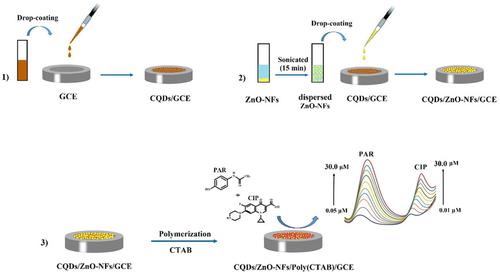当前位置:
X-MOL 学术
›
Electroanalysis
›
论文详情
Our official English website, www.x-mol.net, welcomes your
feedback! (Note: you will need to create a separate account there.)
Carbon Quantum Dots Co‐catalyzed with ZnO Nanoflowers and Poly (CTAB) Nanosensor for Simultaneous Sensitive Detection of Paracetamol and Ciprofloxacin in Biological Samples
Electroanalysis ( IF 2.7 ) Pub Date : 2020-05-03 , DOI: 10.1002/elan.201900412 Behnaz Hatamluyi 1, 2 , Fatemeh Modarres Zahed 3 , Zarrin Es'haghi 4 , Majid Darroudi 5, 6
Electroanalysis ( IF 2.7 ) Pub Date : 2020-05-03 , DOI: 10.1002/elan.201900412 Behnaz Hatamluyi 1, 2 , Fatemeh Modarres Zahed 3 , Zarrin Es'haghi 4 , Majid Darroudi 5, 6
Affiliation

|
A novel platform based incorporation of carbon quantum dots (CQDs) and zinc oxide nanoflowers (ZnO‐NFs) decorated with poly cetyltrimethylammonium bromide (CTAB) was developed as electrochemical sensor for the sensitive and selective simultaneous detection of Paracetamol (PAR) and Ciprofloxacin (CIP) in biological samples. For this, CQDs and ZnO‐NFs were first deposited on a glassy carbon electrode (GCE) and subsequently a Poly (CTAB) layer was grown onto their surfaces through electro‐polymerization. The synthesized nanostructures and the corresponding fabricated sensor were characterized by the techniques of TEM, XRD, FE‐SEM, and EDX analysis. Moreover electrochemical characterization by CV and DPV were performed to elucidate the construction process and electron transfer abilities of the CQDs/ZnO‐NFs/Poly(CTAB)/GCE. Increased sensitivity and efficiency of this sensing system was obtained due to the synergistic effects of CQDs, ZnO‐NFs and Poly (CTAB) with multi‐signal amplification. Under the optimum conditions, the DPV response of proposed sensor to PAR and CIP was linear at 0.05–30.0 μM and 0.01–30.0 μM, with the detection limit of 2.47 nM and 1.97 nM respectively. The sensor possessed high stability, reproducibility, sensitivity, and selectivity toward PAR and CIP detection, over potential interferents and presented high recovery percentage in the real sample matrices.
中文翻译:

碳量子点与ZnO纳米花和聚(CTAB)纳米传感器共同催化,用于生物样品中扑热息痛和环丙沙星的同时灵敏检测
开发了一种基于新型平台的碳量子点(CQDs)和用聚十六烷基三甲基溴化铵(CTAB)装饰的氧化锌纳米花(ZnO-NFs)结合作为电化学传感器的方法,用于对乙酰氨基酚(PAR)和环丙沙星(CIP)的灵敏和选择性同时检测)中的生物样品。为此,首先将CQD和ZnO-NFs沉积在玻璃碳电极(GCE)上,然后通过电聚合在其表面上生长聚(CTAB)层。通过TEM,XRD,FE-SEM和EDX分析技术对合成的纳米结构和相应的传感器进行了表征。此外,通过CV和DPV进行了电化学表征,以阐明CQDs / ZnO-NFs / Poly(CTAB)/ GCE的构建过程和电子转移能力。由于CQD,ZnO-NFs和Poly(CTAB)与多信号放大的协同作用,该传感系统的灵敏度和效率得以提高。在最佳条件下,建议的传感器对PAR和CIP的DPV响应在0.05-30.0μM和0.01-30.0μM处呈线性,检测极限分别为2.47 nM和1.97 nM。该传感器具有对潜在干扰物的高稳定性,重现性,灵敏度和对PAR和CIP检测的选择性,并且在实际样品基质中具有很高的回收率。检测限分别为2.47 nM和1.97 nM。该传感器对PAR和CIP检测具有很高的稳定性,重现性,灵敏度和选择性,可以克服潜在的干扰物,并且在实际样品基质中具有很高的回收率。检测限分别为2.47 nM和1.97 nM。该传感器对PAR和CIP检测具有很高的稳定性,重现性,灵敏度和选择性,可以克服潜在的干扰物,并且在实际样品基质中具有很高的回收率。
更新日期:2020-05-03
中文翻译:

碳量子点与ZnO纳米花和聚(CTAB)纳米传感器共同催化,用于生物样品中扑热息痛和环丙沙星的同时灵敏检测
开发了一种基于新型平台的碳量子点(CQDs)和用聚十六烷基三甲基溴化铵(CTAB)装饰的氧化锌纳米花(ZnO-NFs)结合作为电化学传感器的方法,用于对乙酰氨基酚(PAR)和环丙沙星(CIP)的灵敏和选择性同时检测)中的生物样品。为此,首先将CQD和ZnO-NFs沉积在玻璃碳电极(GCE)上,然后通过电聚合在其表面上生长聚(CTAB)层。通过TEM,XRD,FE-SEM和EDX分析技术对合成的纳米结构和相应的传感器进行了表征。此外,通过CV和DPV进行了电化学表征,以阐明CQDs / ZnO-NFs / Poly(CTAB)/ GCE的构建过程和电子转移能力。由于CQD,ZnO-NFs和Poly(CTAB)与多信号放大的协同作用,该传感系统的灵敏度和效率得以提高。在最佳条件下,建议的传感器对PAR和CIP的DPV响应在0.05-30.0μM和0.01-30.0μM处呈线性,检测极限分别为2.47 nM和1.97 nM。该传感器具有对潜在干扰物的高稳定性,重现性,灵敏度和对PAR和CIP检测的选择性,并且在实际样品基质中具有很高的回收率。检测限分别为2.47 nM和1.97 nM。该传感器对PAR和CIP检测具有很高的稳定性,重现性,灵敏度和选择性,可以克服潜在的干扰物,并且在实际样品基质中具有很高的回收率。检测限分别为2.47 nM和1.97 nM。该传感器对PAR和CIP检测具有很高的稳定性,重现性,灵敏度和选择性,可以克服潜在的干扰物,并且在实际样品基质中具有很高的回收率。











































 京公网安备 11010802027423号
京公网安备 11010802027423号